CHEVROLET TRAVERSE 2009 1.G Owners Manual
Manufacturer: CHEVROLET, Model Year: 2009, Model line: TRAVERSE, Model: CHEVROLET TRAVERSE 2009 1.GPages: 422, PDF Size: 2.06 MB
Page 291 of 422
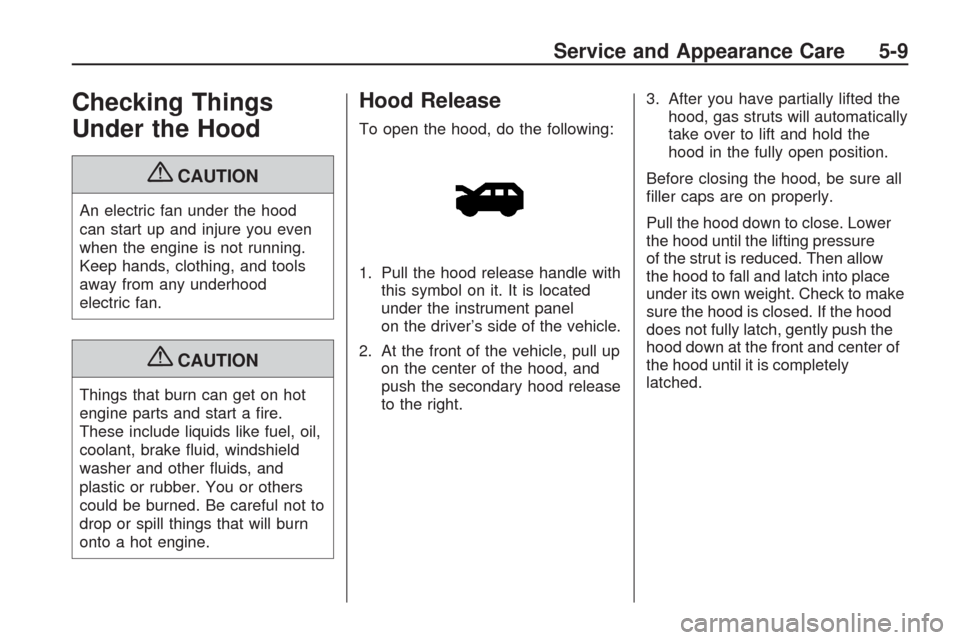
Checking Things
Under the Hood
{CAUTION
An electric fan under the hood
can start up and injure you even
when the engine is not running.
Keep hands, clothing, and tools
away from any underhood
electric fan.
{CAUTION
Things that burn can get on hot
engine parts and start a �re.
These include liquids like fuel, oil,
coolant, brake �uid, windshield
washer and other �uids, and
plastic or rubber. You or others
could be burned. Be careful not to
drop or spill things that will burn
onto a hot engine.
Hood Release
To open the hood, do the following:
1. Pull the hood release handle with
this symbol on it. It is located
under the instrument panel
on the driver’s side of the vehicle.
2. At the front of the vehicle, pull up
on the center of the hood, and
push the secondary hood release
to the right.3. After you have partially lifted the
hood, gas struts will automatically
take over to lift and hold the
hood in the fully open position.
Before closing the hood, be sure all
�ller caps are on properly.
Pull the hood down to close. Lower
the hood until the lifting pressure
of the strut is reduced. Then allow
the hood to fall and latch into place
under its own weight. Check to make
sure the hood is closed. If the hood
does not fully latch, gently push the
hood down at the front and center of
the hood until it is completely
latched.
Service and Appearance Care 5-9
Page 292 of 422
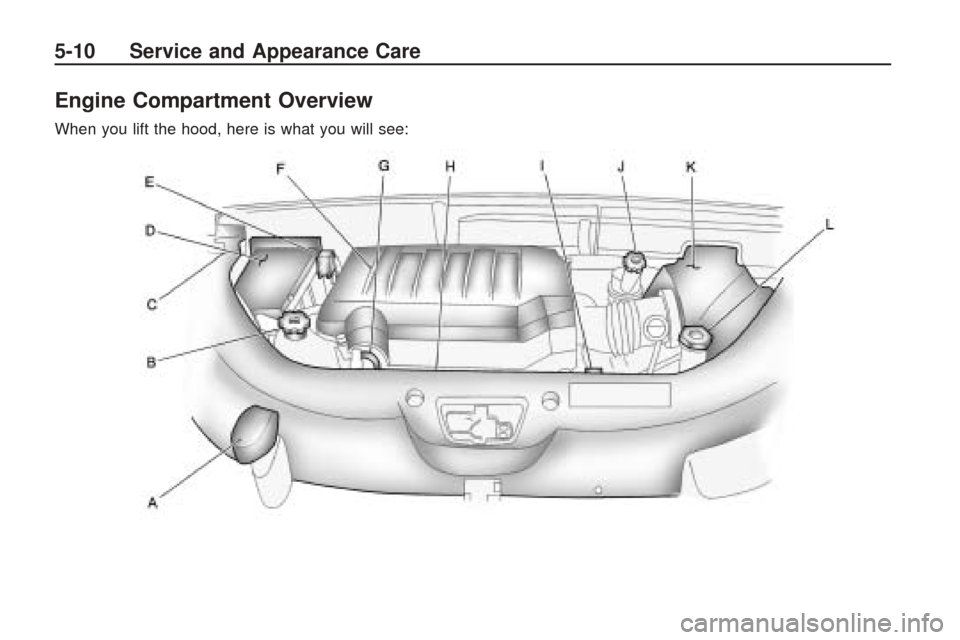
Engine Compartment Overview
When you lift the hood, here is what you will see:
5-10 Service and Appearance Care
Page 293 of 422
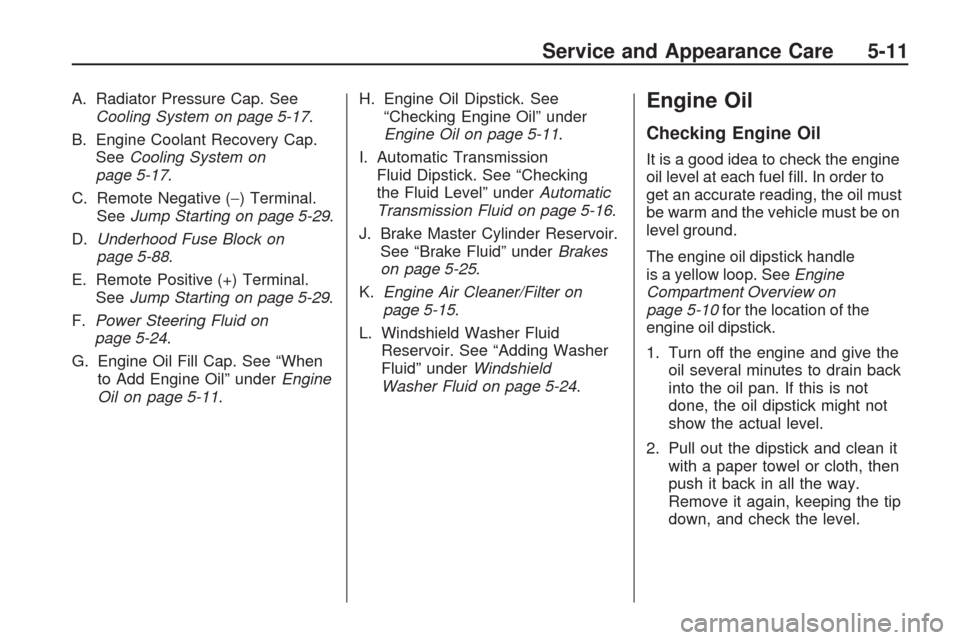
A. Radiator Pressure Cap. See
Cooling System on page 5-17.
B. Engine Coolant Recovery Cap.
SeeCooling System on
page 5-17.
C. Remote Negative (−) Terminal.
SeeJump Starting on page 5-29.
D.Underhood Fuse Block on
page 5-88.
E. Remote Positive (+) Terminal.
SeeJump Starting on page 5-29.
F.Power Steering Fluid on
page 5-24.
G. Engine Oil Fill Cap. See “When
to Add Engine Oil” underEngine
Oil on page 5-11.H. Engine Oil Dipstick. See
“Checking Engine Oil” under
Engine Oil on page 5-11.
I. Automatic Transmission
Fluid Dipstick. See “Checking
the Fluid Level” underAutomatic
Transmission Fluid on page 5-16.
J. Brake Master Cylinder Reservoir.
See “Brake Fluid” underBrakes
on page 5-25.
K.Engine Air Cleaner/Filter on
page 5-15.
L. Windshield Washer Fluid
Reservoir. See “Adding Washer
Fluid” underWindshield
Washer Fluid on page 5-24.Engine Oil
Checking Engine Oil
It is a good idea to check the engine
oil level at each fuel �ll. In order to
get an accurate reading, the oil must
be warm and the vehicle must be on
level ground.
The engine oil dipstick handle
is a yellow loop. SeeEngine
Compartment Overview on
page 5-10for the location of the
engine oil dipstick.
1. Turn off the engine and give the
oil several minutes to drain back
into the oil pan. If this is not
done, the oil dipstick might not
show the actual level.
2. Pull out the dipstick and clean it
with a paper towel or cloth, then
push it back in all the way.
Remove it again, keeping the tip
down, and check the level.
Service and Appearance Care 5-11
Page 294 of 422
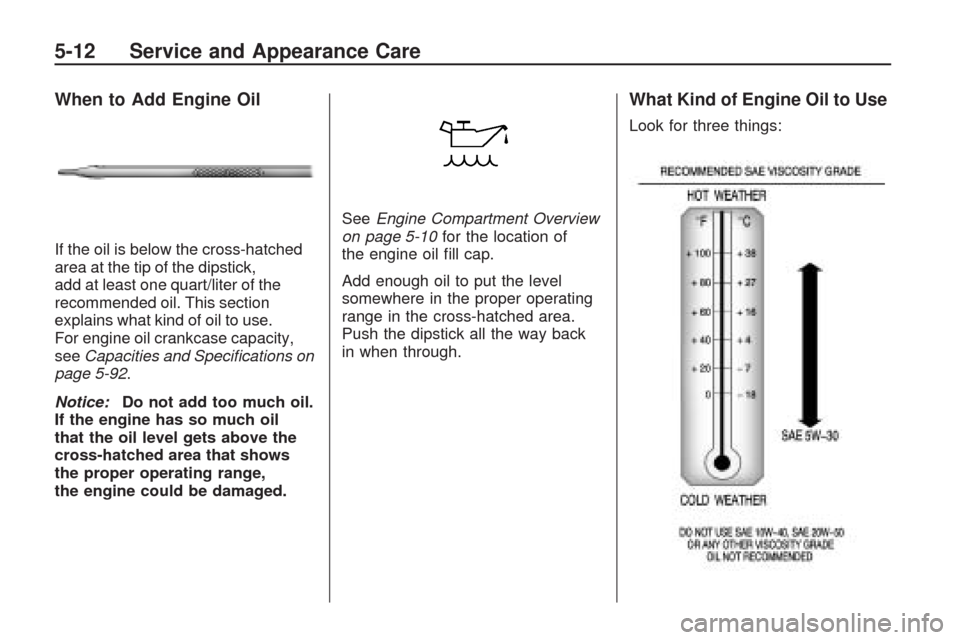
When to Add Engine Oil
If the oil is below the cross-hatched
area at the tip of the dipstick,
add at least one quart/liter of the
recommended oil. This section
explains what kind of oil to use.
For engine oil crankcase capacity,
seeCapacities and Specifications on
page 5-92.
Notice:Do not add too much oil.
If the engine has so much oil
that the oil level gets above the
cross-hatched area that shows
the proper operating range,
the engine could be damaged.SeeEngine Compartment Overview
on page 5-10for the location of
the engine oil �ll cap.
Add enough oil to put the level
somewhere in the proper operating
range in the cross-hatched area.
Push the dipstick all the way back
in when through.
What Kind of Engine Oil to Use
Look for three things:
5-12 Service and Appearance Care
Page 295 of 422
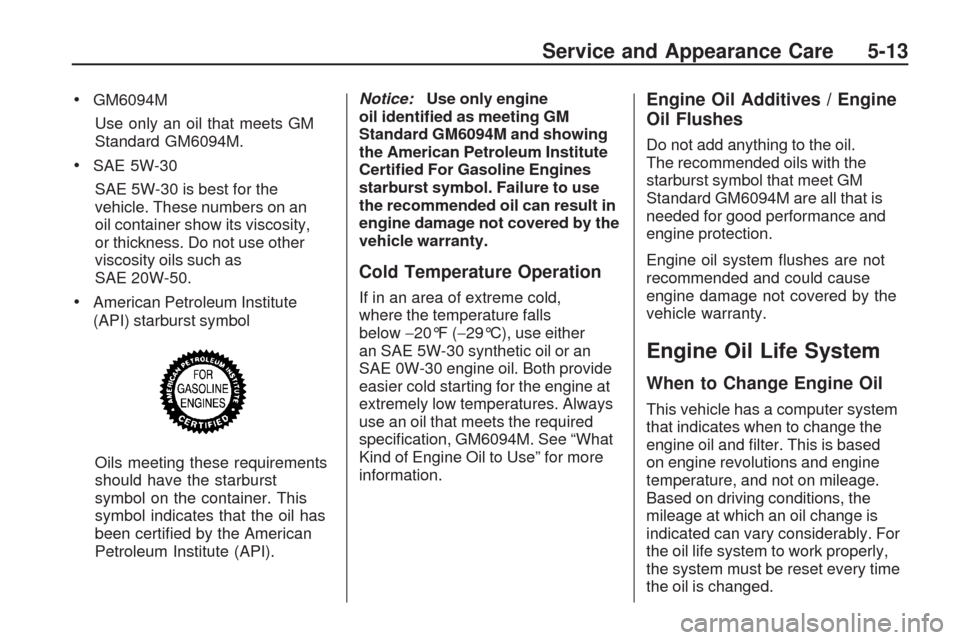
GM6094M
Use only an oil that meets GM
Standard GM6094M.
SAE 5W-30
SAE 5W-30 is best for the
vehicle. These numbers on an
oil container show its viscosity,
or thickness. Do not use other
viscosity oils such as
SAE 20W-50.
American Petroleum Institute
(API) starburst symbol
Oils meeting these requirements
should have the starburst
symbol on the container. This
symbol indicates that the oil has
been certi�ed by the American
Petroleum Institute (API).Notice:Use only engine
oil identi�ed as meeting GM
Standard GM6094M and showing
the American Petroleum Institute
Certi�ed For Gasoline Engines
starburst symbol. Failure to use
the recommended oil can result in
engine damage not covered by the
vehicle warranty.
Cold Temperature Operation
If in an area of extreme cold,
where the temperature falls
below−20°F (−29°C), use either
an SAE 5W-30 synthetic oil or an
SAE 0W-30 engine oil. Both provide
easier cold starting for the engine at
extremely low temperatures. Always
use an oil that meets the required
speci�cation, GM6094M. See “What
Kind of Engine Oil to Use” for more
information.
Engine Oil Additives / Engine
Oil Flushes
Do not add anything to the oil.
The recommended oils with the
starburst symbol that meet GM
Standard GM6094M are all that is
needed for good performance and
engine protection.
Engine oil system �ushes are not
recommended and could cause
engine damage not covered by the
vehicle warranty.
Engine Oil Life System
When to Change Engine Oil
This vehicle has a computer system
that indicates when to change the
engine oil and �lter. This is based
on engine revolutions and engine
temperature, and not on mileage.
Based on driving conditions, the
mileage at which an oil change is
indicated can vary considerably. For
the oil life system to work properly,
the system must be reset every time
the oil is changed.
Service and Appearance Care 5-13
Page 296 of 422
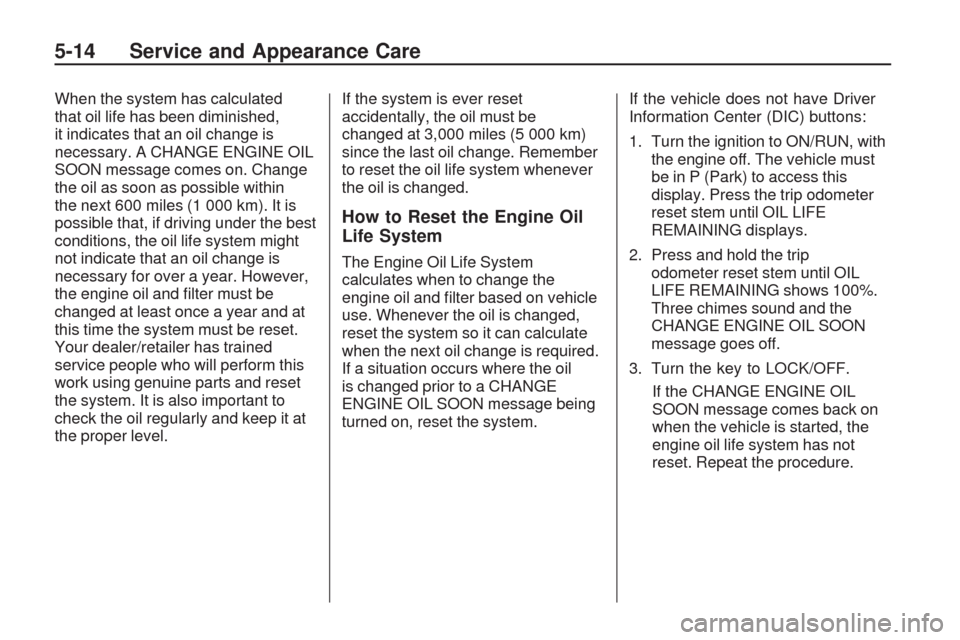
When the system has calculated
that oil life has been diminished,
it indicates that an oil change is
necessary. A CHANGE ENGINE OIL
SOON message comes on. Change
the oil as soon as possible within
the next 600 miles (1 000 km). It is
possible that, if driving under the best
conditions, the oil life system might
not indicate that an oil change is
necessary for over a year. However,
the engine oil and �lter must be
changed at least once a year and at
this time the system must be reset.
Your dealer/retailer has trained
service people who will perform this
work using genuine parts and reset
the system. It is also important to
check the oil regularly and keep it at
the proper level.If the system is ever reset
accidentally, the oil must be
changed at 3,000 miles (5 000 km)
since the last oil change. Remember
to reset the oil life system whenever
the oil is changed.
How to Reset the Engine Oil
Life System
The Engine Oil Life System
calculates when to change the
engine oil and �lter based on vehicle
use. Whenever the oil is changed,
reset the system so it can calculate
when the next oil change is required.
If a situation occurs where the oil
is changed prior to a CHANGE
ENGINE OIL SOON message being
turned on, reset the system.If the vehicle does not have Driver
Information Center (DIC) buttons:
1. Turn the ignition to ON/RUN, with
the engine off. The vehicle must
be in P (Park) to access this
display. Press the trip odometer
reset stem until OIL LIFE
REMAINING displays.
2. Press and hold the trip
odometer reset stem until OIL
LIFE REMAINING shows 100%.
Three chimes sound and the
CHANGE ENGINE OIL SOON
message goes off.
3. Turn the key to LOCK/OFF.
If the CHANGE ENGINE OIL
SOON message comes back on
when the vehicle is started, the
engine oil life system has not
reset. Repeat the procedure.
5-14 Service and Appearance Care
Page 297 of 422
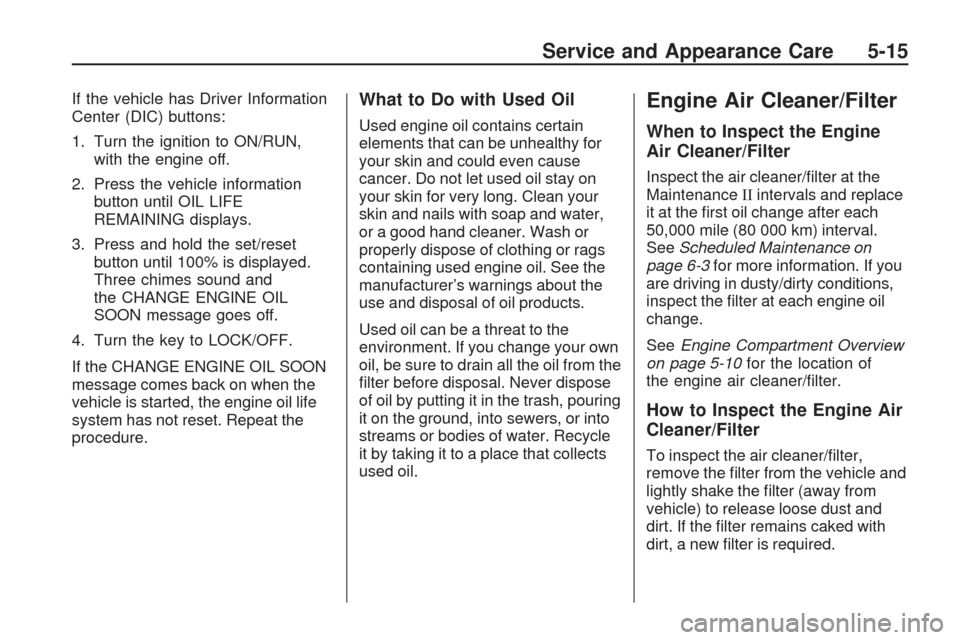
If the vehicle has Driver Information
Center (DIC) buttons:
1. Turn the ignition to ON/RUN,
with the engine off.
2. Press the vehicle information
button until OIL LIFE
REMAINING displays.
3. Press and hold the set/reset
button until 100% is displayed.
Three chimes sound and
the CHANGE ENGINE OIL
SOON message goes off.
4. Turn the key to LOCK/OFF.
If the CHANGE ENGINE OIL SOON
message comes back on when the
vehicle is started, the engine oil life
system has not reset. Repeat the
procedure.What to Do with Used Oil
Used engine oil contains certain
elements that can be unhealthy for
your skin and could even cause
cancer. Do not let used oil stay on
your skin for very long. Clean your
skin and nails with soap and water,
or a good hand cleaner. Wash or
properly dispose of clothing or rags
containing used engine oil. See the
manufacturer’s warnings about the
use and disposal of oil products.
Used oil can be a threat to the
environment. If you change your own
oil, be sure to drain all the oil from the
�lter before disposal. Never dispose
of oil by putting it in the trash, pouring
it on the ground, into sewers, or into
streams or bodies of water. Recycle
it by taking it to a place that collects
used oil.
Engine Air Cleaner/Filter
When to Inspect the Engine
Air Cleaner/Filter
Inspect the air cleaner/�lter at the
MaintenanceIIintervals and replace
it at the �rst oil change after each
50,000 mile (80 000 km) interval.
SeeScheduled Maintenance on
page 6-3for more information. If you
are driving in dusty/dirty conditions,
inspect the �lter at each engine oil
change.
SeeEngine Compartment Overview
on page 5-10for the location of
the engine air cleaner/�lter.
How to Inspect the Engine Air
Cleaner/Filter
To inspect the air cleaner/�lter,
remove the �lter from the vehicle and
lightly shake the �lter (away from
vehicle) to release loose dust and
dirt. If the �lter remains caked with
dirt, a new �lter is required.
Service and Appearance Care 5-15
Page 298 of 422
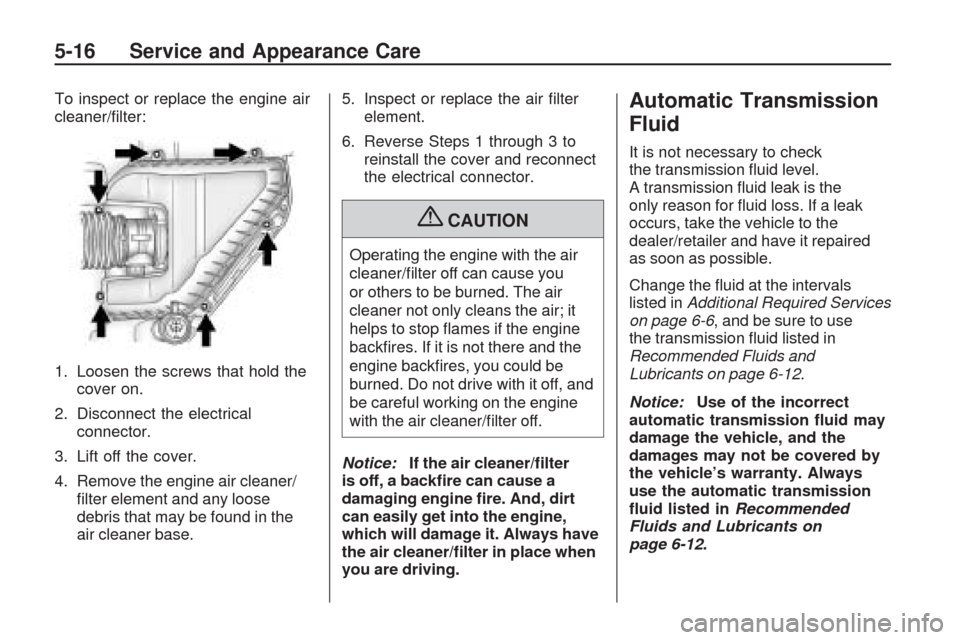
To inspect or replace the engine air
cleaner/�lter:
1. Loosen the screws that hold the
cover on.
2. Disconnect the electrical
connector.
3. Lift off the cover.
4. Remove the engine air cleaner/
�lter element and any loose
debris that may be found in the
air cleaner base.5. Inspect or replace the air �lter
element.
6. Reverse Steps 1 through 3 to
reinstall the cover and reconnect
the electrical connector.
{CAUTION
Operating the engine with the air
cleaner/�lter off can cause you
or others to be burned. The air
cleaner not only cleans the air; it
helps to stop �ames if the engine
back�res. If it is not there and the
engine back�res, you could be
burned. Do not drive with it off, and
be careful working on the engine
with the air cleaner/�lter off.
Notice:If the air cleaner/�lter
is off, a back�re can cause a
damaging engine �re. And, dirt
can easily get into the engine,
which will damage it. Always have
the air cleaner/�lter in place when
you are driving.
Automatic Transmission
Fluid
It is not necessary to check
the transmission �uid level.
A transmission �uid leak is the
only reason for �uid loss. If a leak
occurs, take the vehicle to the
dealer/retailer and have it repaired
as soon as possible.
Change the �uid at the intervals
listed inAdditional Required Services
on page 6-6, and be sure to use
the transmission �uid listed in
Recommended Fluids and
Lubricants on page 6-12.
Notice:Use of the incorrect
automatic transmission �uid may
damage the vehicle, and the
damages may not be covered by
the vehicle’s warranty. Always
use the automatic transmission
�uid listed inRecommended
Fluids and Lubricants on
page 6-12.
5-16 Service and Appearance Care
Page 299 of 422
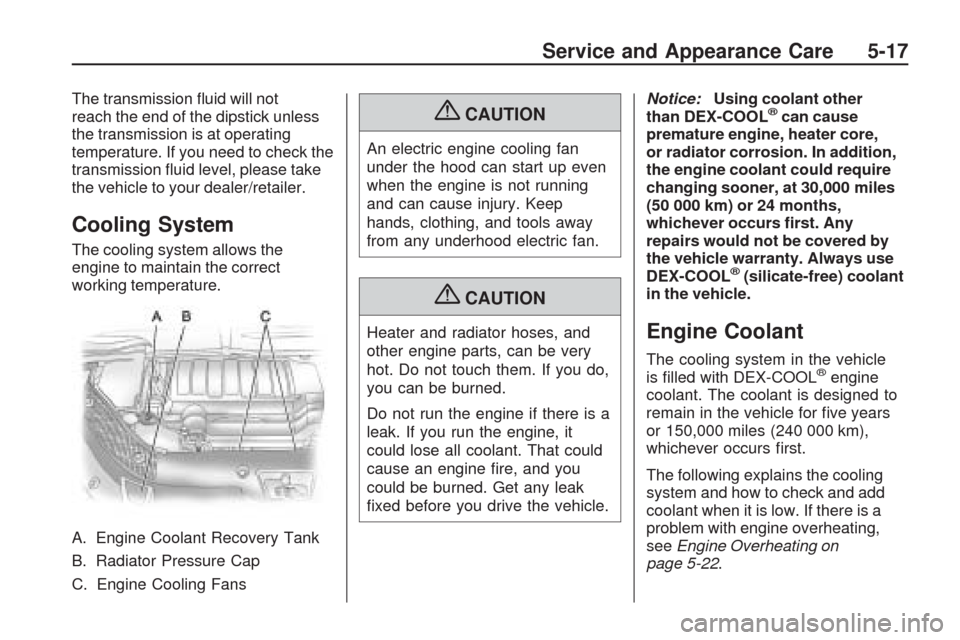
The transmission �uid will not
reach the end of the dipstick unless
the transmission is at operating
temperature. If you need to check the
transmission �uid level, please take
the vehicle to your dealer/retailer.
Cooling System
The cooling system allows the
engine to maintain the correct
working temperature.
A. Engine Coolant Recovery Tank
B. Radiator Pressure Cap
C. Engine Cooling Fans
{CAUTION
An electric engine cooling fan
under the hood can start up even
when the engine is not running
and can cause injury. Keep
hands, clothing, and tools away
from any underhood electric fan.
{CAUTION
Heater and radiator hoses, and
other engine parts, can be very
hot. Do not touch them. If you do,
you can be burned.
Do not run the engine if there is a
leak. If you run the engine, it
could lose all coolant. That could
cause an engine �re, and you
could be burned. Get any leak
�xed before you drive the vehicle.Notice:Using coolant other
than DEX-COOL
®can cause
premature engine, heater core,
or radiator corrosion. In addition,
the engine coolant could require
changing sooner, at 30,000 miles
(50 000 km) or 24 months,
whichever occurs �rst. Any
repairs would not be covered by
the vehicle warranty. Always use
DEX-COOL
®(silicate-free) coolant
in the vehicle.
Engine Coolant
The cooling system in the vehicle
is �lled with DEX-COOL®engine
coolant. The coolant is designed to
remain in the vehicle for �ve years
or 150,000 miles (240 000 km),
whichever occurs �rst.
The following explains the cooling
system and how to check and add
coolant when it is low. If there is a
problem with engine overheating,
seeEngine Overheating on
page 5-22.
Service and Appearance Care 5-17
Page 300 of 422
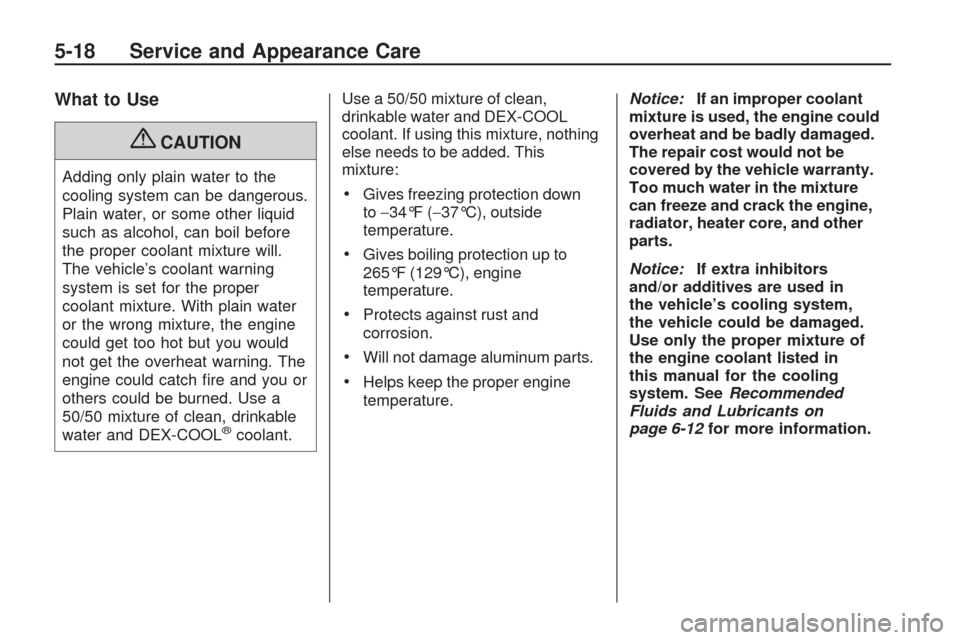
What to Use
{CAUTION
Adding only plain water to the
cooling system can be dangerous.
Plain water, or some other liquid
such as alcohol, can boil before
the proper coolant mixture will.
The vehicle’s coolant warning
system is set for the proper
coolant mixture. With plain water
or the wrong mixture, the engine
could get too hot but you would
not get the overheat warning. The
engine could catch �re and you or
others could be burned. Use a
50/50 mixture of clean, drinkable
water and DEX-COOL
®coolant.Use a 50/50 mixture of clean,
drinkable water and DEX-COOL
coolant. If using this mixture, nothing
else needs to be added. This
mixture:
Gives freezing protection down
to−34°F (−37°C), outside
temperature.
Gives boiling protection up to
265°F (129°C), engine
temperature.
Protects against rust and
corrosion.
Will not damage aluminum parts.
Helps keep the proper engine
temperature.Notice:If an improper coolant
mixture is used, the engine could
overheat and be badly damaged.
The repair cost would not be
covered by the vehicle warranty.
Too much water in the mixture
can freeze and crack the engine,
radiator, heater core, and other
parts.
Notice:If extra inhibitors
and/or additives are used in
the vehicle’s cooling system,
the vehicle could be damaged.
Use only the proper mixture of
the engine coolant listed in
this manual for the cooling
system. SeeRecommended
Fluids and Lubricants on
page 6-12for more information.
5-18 Service and Appearance Care